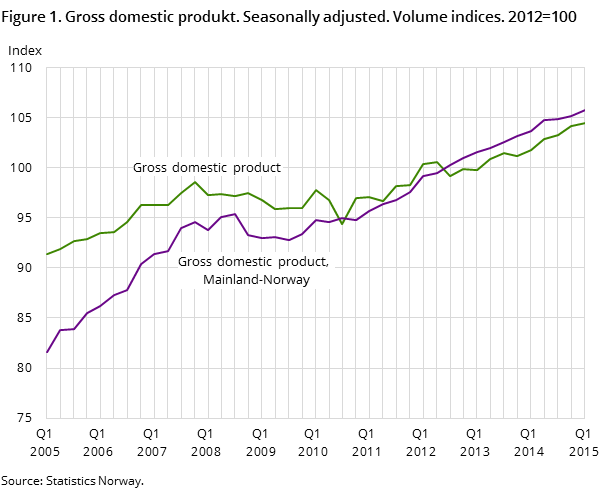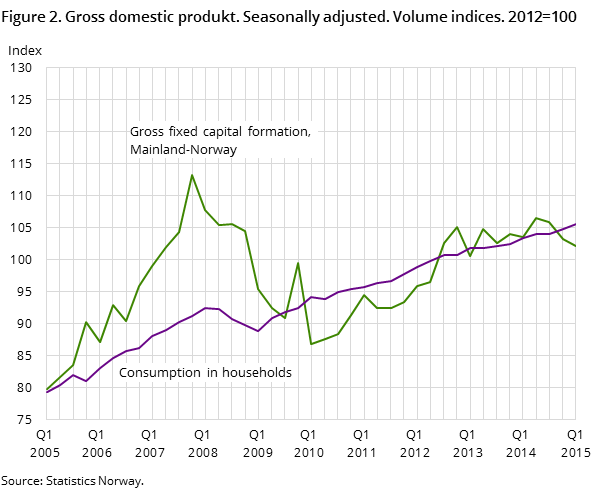Content
Published:
This is an archived release.
Weak GDP growth
According to seasonally-adjusted figures, gross domestic product for Mainland Norway rose by 0.5 per cent in the 1st quarter of 2015, while the growth in the second half of 2014 has been revised downwards to a growth of 0.4 per cent. For the first time since the 2nd quarter of 2010, there was no growth in employment.
| 2014 | 2nd quarter 2014 | 3rd quarter 2014 | 4th quarter 2014 | 1st quarter 2015 | |
|---|---|---|---|---|---|
| 1Figures for the last two years are preliminary. | |||||
| Gross domestic product | 2.2 | 1.0 | 0.4 | 0.9 | 0.2 |
| Gross domestic product Mainland Norway | 2.2 | 1.1 | 0.0 | 0.4 | 0.5 |
| Petroleum activities and ocean transport | 2.1 | 0.9 | 1.9 | 2.6 | -0.7 |
| Final domestic use of goods and services | 1.9 | 2.1 | 0.5 | -1.7 | 2.9 |
| Final consumption expenditure of households and NPISH | 2.0 | 0.6 | 0.1 | 0.8 | 0.6 |
| Final consumption expenditure of general government | 2.7 | 0.6 | 0.5 | 0.7 | 0.3 |
| Gross fixed capital formation (GFCF) | 0.6 | 2.3 | -1.2 | -3.9 | -0.3 |
| Total exports | 2.7 | 0.4 | 2.6 | 3.4 | -3.8 |
| Total imports | 1.9 | 3.6 | 3.4 | -3.6 | 2.8 |
| Employed persons | 1.1 | 0.3 | 0.2 | 0.2 | 0.0 |
| Total hours worked | 1.6 | 0.4 | 0.2 | 0.2 | -0.1 |


Value added in manufacturing and mining fell in the 1st quarter by 0.8 per cent following a sharp slowdown of the growth in the second half of 2014. The decline was partly due to lower production in the petroleum-related supply industry, such as repair and installation of machinery and equipment as well as shipbuilding. There was also a decline in resource-based industries. Several other competitive industries also had weak growth, but the decline was offset by increased production of machinery and chemical and pharmaceutical products.
Goods production other than manufacturing showed an increase in the 1st quarter. Value added in construction rose by 0.8 per cent, following a similar decline in the 4th quarter last year. Production growth in construction activities has otherwise been high since 2010. Electricity production as well as fishing and aquaculture also increased in the 1st quarter. Overall, growth in other goods was 0.7 per cent in the 1st quarter.
The activity level in service industries excluding general government showed moderate growth through 2014 and increased by 0.7 per cent in the 1st quarter, following a growth of 0.3 per cent in the previous quarter. Value added in the public sector increased by 0.6 per cent in the 1st quarter. In the 3rd quarter of 2014, growth in government was dampened by the teachers strike in local government.
Value added in petroleum activities and ocean transport declined 0.7 per cent in the 1st quarter, which contributed to a growth in total GDP in the 1st quarter of 0.2 per cent.
Moderate growth in consumption
Household consumption rose by 0.7 per cent in the 1st quarter. With the exception of the 3rd quarter, which had a weak growth due to a slight decrease in goods consumption, household consumption had a stable and moderate growth through last year. Consumption of goods increased by 0.5 per cent in the 1st quarter. This growth was drawn up by a sharp rise in car purchases and consumption of clothing and shoes. Purchases of non-durable goods, however, were unchanged from the previous quarter. Consumption of services increased by 0.9 per cent in the 1st quarter.
After several years of strong growth in household consumption abroad, growth levelled off at the end of last year and fell by 0.5 per cent in the 1st quarter.
Consumption in general government was 0.3 per cent higher than in the 4th quarter of 2014. Consumption growth in local government was clearly weaker than in the central government.
Decreased investments
Gross fixed capital formation (GFCF) in Mainland Norway fell by 0.3 per cent in the 1st quarter, following a decline also in the two preceding quarters. GFCF in manufacturing and mining fell by approximately 20 per cent. The decline was particularly sharp for resource-based industries and building of ships.
Government GFCF increased, however, and was 4.1 per cent higher than in the 4th quarter, after two consecutive quarters of decline. Household investments in dwellings grew by 0.9 per cent, after a weak development throughout 2014.
The preliminary figures show that petroleum GFCF increased by 0.8 per cent in the 1st quarter. Investments peaked in the 3rd quarter of 2013, and then decreased gradually. The estimate for the 4th quarter, which was published in February, has been revised downwards.
Increased exports and imports of traditional goods
There was an increase in exports of traditional goods of 0.8 per cent in the 1st quarter. Imports of traditional goods increased by 4.4 per cent, following a decline the previous quarter.
No employment growth
In the 1st quarter this year, employment was unchanged from the previous quarter, following a steady increase of between 0.2 and 0.3 per cent each quarter last year. Employment has increased steadily since the 2nd quarter of 2010. Hours worked was 0.1 per cent lower than in the 4th quarter of 2014. The number of hours worked increased by 0.2 per cent in each quarter in 2014, with the exception of the 2nd quarter when growth was 0.4 per cent.
Revisions of previous quarters
In conjunction with the release of figures for the 4th quarter, figures for all four quarters in 2014 were subject to minor revisions following the incorporation of new information. GDP growth for mainland Norway in 2014 is revised down from 2.3 per cent to 2.2 per cent at constant prices. The seasonally-adjusted growth picture has thus changed somewhat for the mainland economy in the second half of 2014, and shows a weaker development than in the publication of the 4th quarter of 2014.
The growth of total GDP for Norway in 2014, unchanged from the previous release, with growth of 2.2 per cent in 2014.
New information has given an upward revision of both imports and exports. It is in particular imports and exports of services that are revised upwards. GFCF is adjusted downward in 2014.
Household consumption has been revised downwards in 2014 by 0.3 percentage points. The revision is due to new information on consumption abroad and tobacco consumption.
For an overview of the revisions in the main aggregates in the last quarters, see table 48.
For more information on compilation methods and seasonal adjustment practice, please see About the statistics and On seasonal adjustment of the quarterly national accounts.
For an overview of the development in the GDP of some of our trading partners, please refer to the link to OECD statistics under Other websites.
Main revision of the national accountsOpen and readClose
Statistics Norway has made a main revision to the national accounts. The first results from this revision were published on 20 November 2014. The revisions are partly due to new international recommendations on national accounting and partly the results of improved methods of estimations and new sources. Read more about the main revision.
Concepts and definitions in National AccountsOpen and readClose
For more information about definitions of the main concepts, variables and classifications in national accounts, see About the statistics, definitions.
How the figures are calculatedOpen and readClose
The sum of four quarters in the Quarterly National Accounts (QNA) makes up the preliminary annual figures until the Annual National Accounts (ANA) for year t are published in November in year t+2 and incorporated as a new base year in the QNA. Hence, 2011 is the base year in the QNA when publishing data in May 2014.
In both the ANA and QNA, the figures stripped of movements in prices are referred to as volume changes, or fixed price estimates in the QNA, and this is done to identify the underlying cyclical pattern of the economy.
Note that in the time series in volume, the figures from the base year and onwards are fixed price figures, while data prior to the base year are chained volume figures. This implies that additivity in volume is lost prior to the base year.
Contact
-
Pål Sletten
E-mail: pal.sletten@ssb.no
tel.: (+47) 99 29 06 84
-
Ingunn Sagelvmo
E-mail: ingunn.sagelvmo@ssb.no
tel.: (+47) 40 90 26 32
-
Pia Tønjum
E-mail: pia.tonjum@ssb.no
tel.: (+47) 48 99 12 07
-
Kristian Gimming
E-mail: kristian.gimming@ssb.no
tel.: (+47) 91 88 39 06
